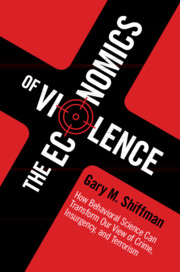 The Economics of Violence
The Economics of Violence Book contents
- The Economics of Violence
- Reviews
- The Economics of Violence
- Copyright page
- Dedication
- Contents
- Acknowledgments
- Introduction
- 1 Violence
- 2 The Human Condition
- 3 Organized Crime
- 4 Insurgency
- 5 Terrorism
- 6 The Rise of the Islamic State in Al Qaeda’s Market
- 7 Conclusions and Prescriptions
- Final Thoughts
- Glossary of Terms
- Notes
- Index
Introduction
Published online by Cambridge University Press: 10 January 2020
- The Economics of Violence
- Reviews
- The Economics of Violence
- Copyright page
- Dedication
- Contents
- Acknowledgments
- Introduction
- 1 Violence
- 2 The Human Condition
- 3 Organized Crime
- 4 Insurgency
- 5 Terrorism
- 6 The Rise of the Islamic State in Al Qaeda’s Market
- 7 Conclusions and Prescriptions
- Final Thoughts
- Glossary of Terms
- Notes
- Index
Summary
During the first year of my transition from military service to staffing US Senate leaders on Capitol Hill, I began working on how to counter acts of terrorism. The year was 1996, and I had served on active duty as a Surface Warfare Officer in the US Navy since 1988. I understood important military concepts such as the capabilities of various Russian-made weapons systems and the impact of Tomahawk cruise missile technology on air superiority. Still, my experience did not help me comprehend how to tackle suicide terrorism.
- Type
- Chapter
- Information
- The Economics of ViolenceHow Behavioral Science Can Transform our View of Crime, Insurgency, and Terrorism, pp. 1 - 6Publisher: Cambridge University PressPrint publication year: 2020
